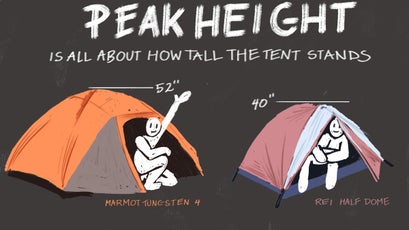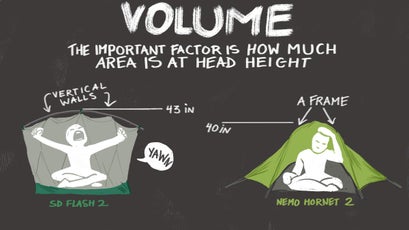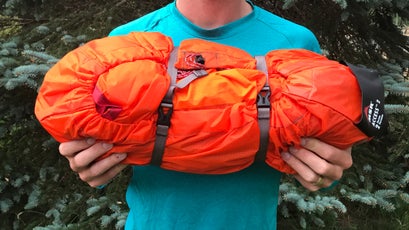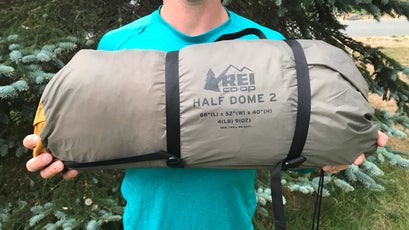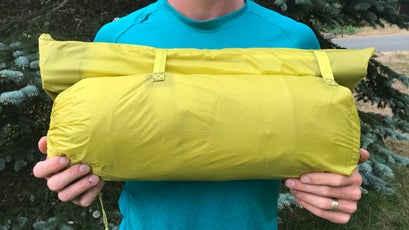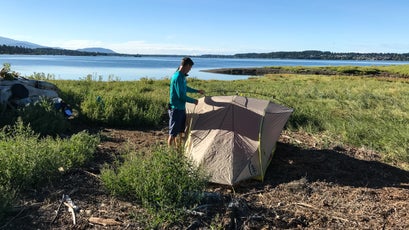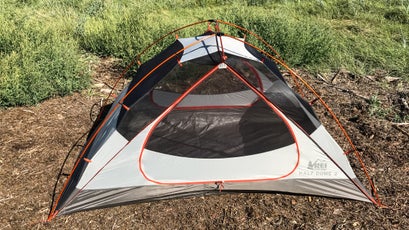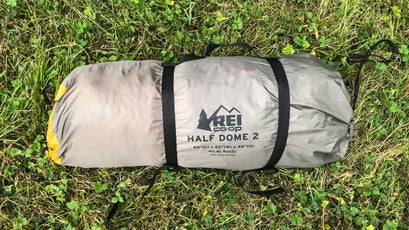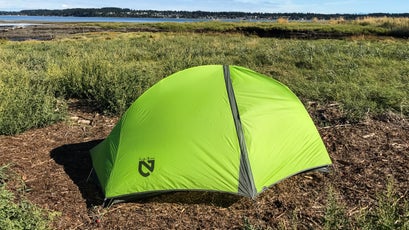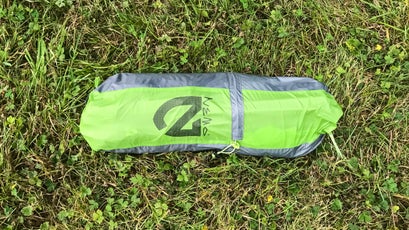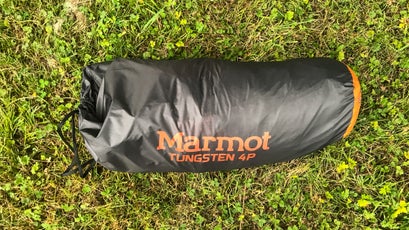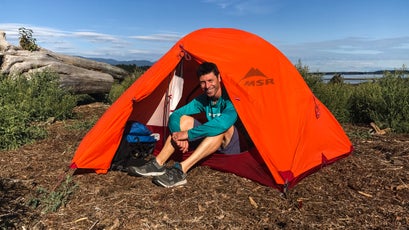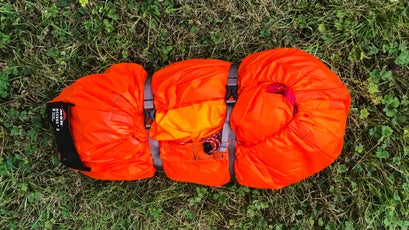Outside has reviewed backpacking tents for 40 years, and during that time we’ve tested a lot of well-designed models. But if we had to choose the best all-around tent to take backpacking right now, we’d buy the Sierra Designs Flash 2 FL. We love the Flash 2 FL because it’s fast and simple to set up, easy to get in and out of, weighs less than two pounds per-person, packs up compact, and has held up to years of use from out testers. To find out more about why we'd recommend the Flash 2 FL, and gain some useful tips for how to find your own perfect tent, read on.
What Should You Know Before Buying a Backpacking Tent?
Imagine a spectrum of tents lined up according to size and weight. On one end you’d have ultralight shelters. These fragile and minimalist abodes are like rain jackets for your sleeping bag. They’re designed to shave ounces, usually at the expense of comfort, and are popular with folks like thru-hikers who want to travel light. Spending a night in one means getting intimate with your tent mate. At the other end of the spectrum are car camping tents. Heading toward palatial, these mobile homes focus more on interior space and comfort. They’re too heavy to carry more than a 100 yards, hog serious backpack real estate, and often require teamwork to set up.
A good backpacking tent should fall somewhere in the middle. They’re compact enough to carry on your back for miles, but are made of tougher fabrics than an ultralight tent, have more square footage and elbow room. And they also come with small luxuries like pockets. Compared to car camping mansions, backpacking tents are smaller, lighter and easier to set up. They’re versatile tents designed for adventure.
Of course, there are several types of backpacking tents. We recommend a double-wall style. Typically, these include an internal tent body made from bug-proof mesh or lightweight nylon, and an external, waterproof fly. The gap between the body and fly encourages airflow to prevent moisture buildup inside. And if any condensation does collects on the inside of the fly, the gap keeps your sleeping bags and clothing from getting wet. All of our top-choice tents listed below are a double-wall style.
In a single-wall tent, the body and fly are the same thing. Eliminating the mesh cuts weight, but single-wall tents tend to be hot, and condensation can be an issue. This style of tent is usually reserved for mountaineering. A third style combines the two into a hybrid design. Taking the best of both can create excellent tents, like our favorite backpacking tent the Sierra Designs Flash 2.
How Should You Choose a Tent?
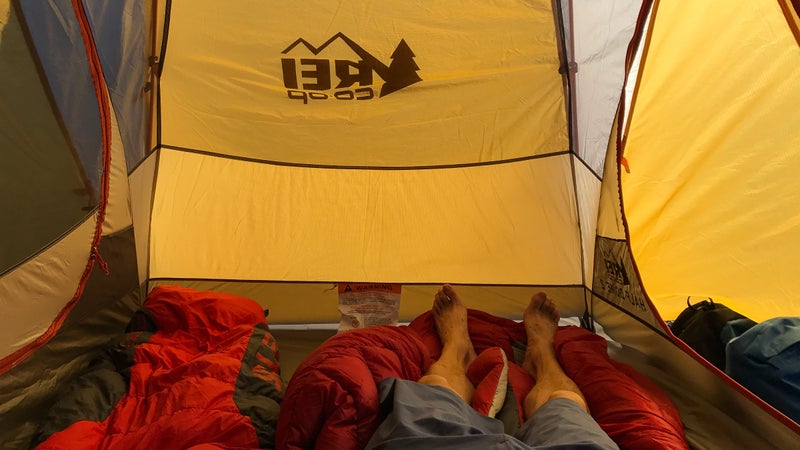
Tent Capacity
One of the first questions to ask before buying a tent is, how many people do you need to house? We used to recommend spacing up, or buying a three-person tent if there were two of you, and so on. But nowadays, tent designers have found unique ways to add extra elbow room without adding weight, so now we recommend buying a two-person tent for two people.
The exception is when you’re solo camping, or camping with kids and dogs. Solo campers could buy a one-person tent, but we often prefer a lightweight two-person shelter for the extra space and minimal weight gain. Campers who have kids, and or dogs, should consider that smaller body a full-size adult body to ensure enough space. Two adults with a kid, or two adults with a dog, should buy a three-person tent. Two adults with a dog and a kid, or two adults with two kids, should buy a four-person tent. Larger groups should consider dividing into smaller tents.
The best way to measure whether you’ll fit comfortably in a particular tent is to climb in a demo model. If that’s not an option, there are a few things you need to know about the ways manufacturers describe tents. First, your standard two-person tent should have about 30 square feet of internal floor space. Some tents will be a little longer; a good choice if you’re well over six feet tall. And a newer category of tents called “plus size” or high volume, add extra floor space and headroom to give a roomier feel without much weight penalty. Peak roof heights average around 42 inches. That’s enough for most people to sit up without brushing their heads. Other things to look for: pole structures that create vertical walls, particularly cross poles, multiple hubs, and pre-bent or “kneed” poles that create vertical walls, and high peak heights and large vestibules for storing gear outside of the tent.
However, none of this data alone tells you what it’s like to hang out, play cards, or even put on a pair of pants in a tent. To understand that requires the hard-to-measure variable of useable volume: aka elbow room. NEMO, Marmot, Sierra Designs, and SlingFin have all taken a stab at measuring and displaying this (NEMO does it best), but we still stand by our recommendation to get in your tent if possible.
Tent Weight
Weight is often the most talked about variable. It’s easy to quantify, and you’ll feel it every step of the trip. But there’s actually not much of a weight spread in today’s tents. The lightest backpacking tents usually weigh just under two pounds per-person, while the most budget-friendly tents usually weigh less than three pounds per person. That’s less than one fuel bottle or the difference between an empty and half-full water bottle. It’s not a lot.
Heads up: when you’re comparing weights make sure it’s apples to apples. Tentmakers will often list more than one weight per-tent. For instance, they’ll list minimum, packaged, pack, trail, maximum, etc. All these weights are measured slightly differently. For your reference, all the weights we list on our recommended tents were recorded using our own Park Tools bike scale, and those weights include the tent, fly, stuff sacks, and eight pegs.

Tent Price
We think the sweet spot for backpacking tents in the $200 to $500 range. Tents under $200 tend to be heavy, not very durable, often lack a full fly (so there aren’t any vestibules), and come with suspect waterproofing. Above $500, the law of diminishing returns tends to apply. With a few exceptions, these pricey tents use expensive fabrics and materials that won’t significantly impact your backpacking experience.
In that range, you’re going to notice differences in weight, quality of materials, and quantity of features. Up at $500, the tents will have lots of pockets, vents, multiple peg out points, top-notch construction, vertical walls, two doors and two vestibules, and they’ll still weigh in around two pounds per-person. Down at $200, the tents will be heavier or more fragile, will come with fewer features and less elbow room, and will probably only have one door.
Tent Packability
All tents are bulky, but the smaller they pack down, the more chocolate and Scotch you can bring. Or, with a well-packed tent, maybe you can carry a lower volume pack, which cuts weight. Tents vary in size, but most two-person tents should pack into a cylinder about 20-inches long and six inches in diameter.
Tent Durability
Higher quality materials make a tent last longer. But higher quality materials also drive up the price. Fabric and poles are the two easiest to understand in terms of toughness. Tent makers use lots of different nylons, mesh, and polyesters on the body and fly. In general, the higher the denier (a weight based on 9,000 meters of yarn), the stronger the fabric. But you should only make denier comparisons between the same types of fabrics since each fabric performs differently.
Most backpacking tents use aluminum poles, typically made by DAC or Easton. Sometimes the quality of the aluminum is also listed—frequently it’s 6,000 or the slightly stronger 7,000. Some high-end tents use carbon fiber poles. These poles are lighter, thinner and tougher, but harder to repair if they break.
Three other metrics to watch for: stitch count, and the quality of zippers and webbing.
Ease of Setup
Nothing’s more frustrating at the end of a long day than wrestling tent poles into position or even worse, setting a tent up wrong and having to start again. Things that make set up faster and easier include: color-coded poles, grommets and webbing, symmetrical designs, simple pole structures, and poles that attach to the vestibule rather than the tent.
The easiest tents are domes or A-frames. With only two or three straight poles, they’re simple but the compromise is elbow room. Multiple hubs and pre-bent pole structures, on the other hand, are often confusing the first time you set them up, but get you more room.
How poles attach to the tent matters, too. Few tents use sleeves anymore because pushing and pulling the poles through the tubes of fabric often results in snags or the poles coming apart. Instead, clips are now the standard and what we recommend because they’re fast and secure. The binding, where the poles attach to the tent, can vary from a simple ring to a ball and socket system that snaps together. The latter are nice, especially for solo setups, because the pole won’t pop out unexpectedly.
Free-standing tents are the best: once they’re set up they stand on their own without the need for pegs and ropes. They’re easy to set up, even by yourself, and can be picked up and moved. Non-freestanding tents need to be pegged and use ropes to tension at least some, if not all the walls. With fewer poles, they tend to be less expensive and lighter weight, but require more fiddling and sometimes help from another person.
Tent Features
Tents tend to be fairly basic, but there are some with built-in lighting like the Big Agnes Rattlesnake SL3 Mtnglo, and the Big Agnes Krumholtz UL2 MtnGlo comes with its own lighting, solar power, battery bank, and fan. Keep in mind that features like these tend to increase the price, so consider which conveniences you really need. We think it’s worth extra to pay for two doors, two vestibules, multiple pockets, two-way zippers, and vents in the fly to help with air flow. We’re also fans of extra guy-out points that all you to attach ropes to your fly to tighten it for better performance in the wind and rain. Tip: reflective guy-out lines prevent tripping in the dark.

And finally, you have footprints. These are ground sheets that go under the tent and protect your tent floor from dirt and tears. They’re usually an add-on, and we don’t find them necessary. However, they will extend the life of a tent.
How We Picked the Best Tent for Backpacking
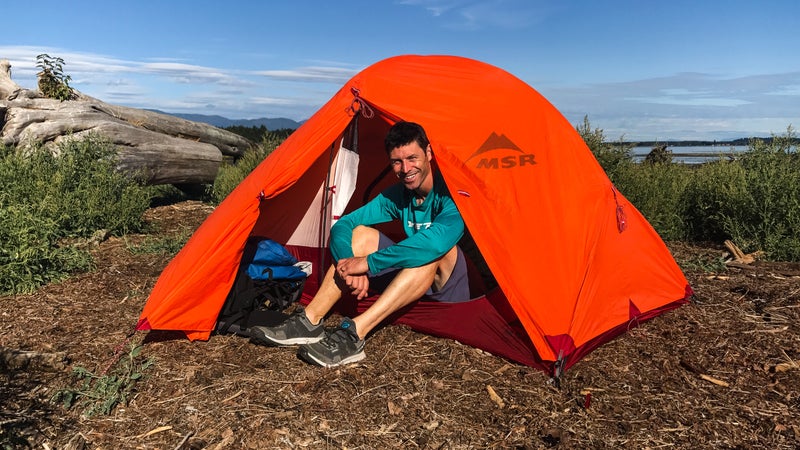
My name is Ryan Stuart and I directed this entire review. I’ve been backpacking for the last 25 years and have also worked as a backcountry guide where I spend months on end living out of tent. At Outside, I review 20 to 30 tents each year for the summer Buyer’s Guides and have probably tested over 100 tents total.
For the Buyer's Guides, I set up every tent myself and run each one through a series of tests in my yard. I spray them with a hose, expose them to storms and rain, climb in and out, and even work on my laptop from inside. Each tent also goes camping for a real-world test. I take most of them, but also seed some out to other testers who take them on family canoe trips and multi-week expeditions. At the end of the test period, I gather all the feedback and compare specs. Then, I pass my findings by Outside’s editors, who also live the life and test gear all the time. Together we pick the best tents of each year.
Afterwards, the testing continues. I want to see how our favorite tents stand up to years of use and abuse, different environments, and the constant pace of innovation. I also look at what other people are saying. By reading online comments, reviews from at Backcountry.com, REI.com and other sites and talking with retail staff and other professional gear reviewers, I see how my picks stack up.
When I review tents for the magazine, I'm looking at the latest releases so I can stay on top of new developments. For the review you’re reading right now, I picked the top-performing tents for specific categories (two-person, one person, rainy climates, etc.) without worrying about whether the tent was new. What I’m suggesting here are the best tents, period. Even if they’re a couple years old, I think these tents still out-perform the newer competitors.
To ensure my reviews were fresh, I went back to my notes, but also tracked down all the suggested tents and slept in each one again. I also left them up in the rain and wind, sprayed them with a hose once again, and set up a couple air mats and sleeping bags and played cards with my daughter to gauge roominess. Then I packed them all up, checked in with my editor, and started writing.
Our Favorite Backpacking Tents, Ranked
Best Overall Backpacking Tent: Sierra Designs Flash 2 FL ($400)
I have a lot of tents in my basement, but for the last five years, my favorite go-to has been the Sierra Designs Flash 2 FL. The biggest reason: its unique design. The tent and fly are integrated, and to pitch the tent, you just clip the poles to the outside of the fly and the tent rises in one step instead of two like most other tents. This makes the Flash 2 quick to pitch and it also means the inside of the tent is never exposed to rain. On a backpacking trip with friends, we all started setting up our tents at the same time. I was inside in almost half the time and my tent was dry while everyone else had a damp floor.
The pole structure can be confusing to the uninitiated: it’s a dizzying single pole, three-hubbed hoop system. But it’s actually pretty simple. It creates vertical walls at either door and a 43-inch peak that runs from one door right across to the other, rather than one high point, creating a nice airy feeling.
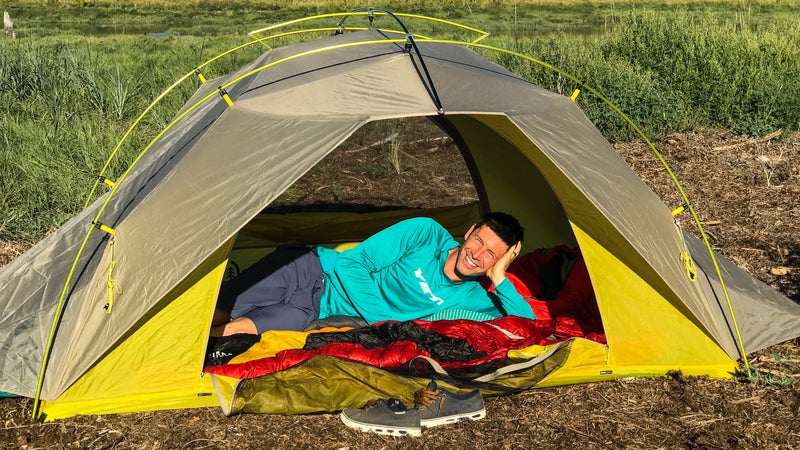
The most unique feature is a lack of vestibules at the doors. Instead, the fly overhangs the weatherproof door, sort of like a foot-long awning. In anything but sideways rain, the overhang keeps the rain off the door. When the wind is whipping, the door keeps everything dry inside. The point was to create a super easy entry and exit and eliminate clunky vestibules that can be hard to crawl through.
Don’t fret, though, because the tent still had plenty of outside gear storage. Two “gear lockers,” or mini vestibules hang off the sides and will store your pack. They’re accessed through zippers on the inside of the tent.
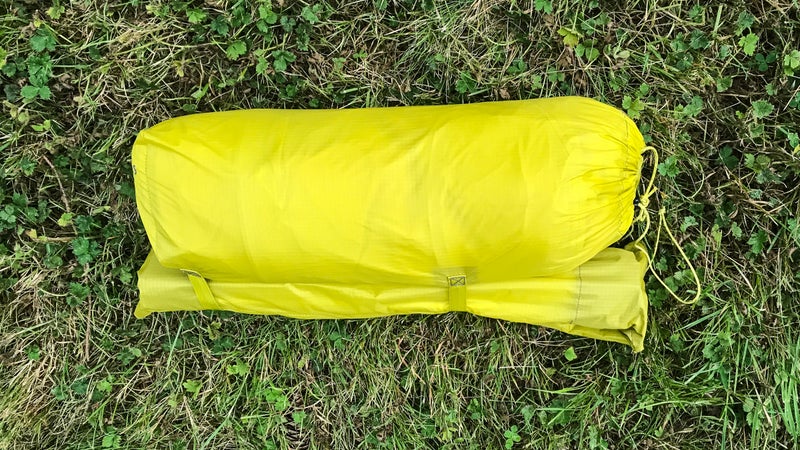
Our other preconceived concern—condensation with the hybrid wall—turned out to be a non-issue too. With plenty of mesh on the doors and over the center, air moves freely and condensation never collected in a place that it could contact a sleeping bag.
The FL is a lighter weight version, ditching a pound for about $100. I think it’s worth the extra money, but if you can’t afford the splurge, you still get all the same design features in the regular Flash 2.
Best Affordable Backpacking Tent: REI CoOp Half Dome 2 ($200)
With you the Half Dome 2 you get an ultra-dependable, two-person, five-pound tent that packs down reasonably well for $200. That pricing is thanks to REI’s power as the nation’s largest outdoor retailer. Don’t expect anything fancy or innovative or cutting edge in this long-time REI favorite, but you will love the performance.
All the Half Dome 2s I’ve tested were made from durable nylons that stood up to abuse without a leak or tear. The hubbed aluminum pole set up is simple to pitch solo, and the symmetric design means there’s no confusion about how to lay out the fly. A friend who hadn’t set up a tent in years figured the Half Dome out in minutes without instructions.
The pole system lifts the tent to a 40-inch peak and creates 32 square-feet of floor area—both of which are average for the category—while a cross pole at the peak pushes the side walls close to vertical. On a drizzly evening I hung out in here with two friends without feeling claustrophobic. (If you want more room check out the “plus” version, which adds more space in every department.)
There are other “budget” tents that have similar stats, but the Half Dome stands apart because it’s more feature rich. At this price point we expect minimalism, but the Half Dome has several pockets and hang loops for organizing the interior. Guylines in all key areas on the fly help snug up the pitch. Each of the two oval doors opens into an eight-square-foot vestibule. The fly rolls up for star gazing and then quickly flips back into place if the weather changes. You can bring the fly, poles, and the optional footprint for a super light set up. And, you can choose from six different fly colors, a rare customizable option in tent buying.
If you backpack a lot, you might look elsewhere for a lighter tent. But if you just head out a couple times each year, there’s no better tent for the money.
Best One-Person Backpacking Tent: Nemo Hornet 2 ($370)
As the “2” suggests in the names, this is a two-person tent, but I think it makes more sense as a roomy one-person shelter. The single pole structure creates an A-frame feel, which makes things cramped for two people. Let’s just say you’d want to be intimate—or hoping to—with a tent mate: two adults couldn't sit up at the same time without touching noggins. But solo this ultralight tent feels palatial without weighing you down.
At about 2.4 pounds, and 19 inches by 5 inches when packed into its cylinder case, it was no burden on a Canadian Rocky Mountains backpacking trip. Nemo achieved the impressive weight by using the lightest aluminum available for the poles and small gauge nylon on the fly (10-denier), floor (15-denier) and canopy (20-denier). Those are pretty standard deniers for an ultralight tent, but the materials need to be treated gently to make them last. And by that I mean you shouldn't worry too much about everyday use, but you don't want to drag any of them against a tree.
The one-pole design is semi-freestanding; once the tent is clipped in place with the poles it stands on its own but still needs pegging to get the full area spread out. It’s easy to set up solo with a few pegs. The fly reaches to the ground for total coverage of the all-mesh body. During a windy storm at an exposed camp, not a bead made it inside. A tester reported the steep walls and a few well-positioned guy-out points dumped the deluge away from the tent.
The two vestibules are small and slightly difficult to climb through, but that’s typical for small tents. Once inside, there’s plenty of room for a bed down the middle and space on both sides for stuff sacks and gear. One of the pockets held my headlamp and book. The other, a beanie. I stored my pack in one of the eight-square-foot vestibules, leaving the other unencumbered for an entrance.
Best Backpacking Tent for Families: Marmot Tungsten 4P ($340)
When you’re camping with your partner and a kid, or two, and maybe the dog, you could bring two tents. But I think piling into one tent is better. Half the reason I camp with the family is to enjoy time together. And with the Tungsten 4, you won’t be sleeping on top of each other when the bonding stops. At 8.8 pounds it’s going to feel heavy if you carry it all, but it’s one of the lightest tents available for its square footage, at just over two pounds per-person. Two main poles, running diagonally corner to corner, are bent to create more volume at the head and feet. Two cross poles push the door walls towards vertical.
You get 53 square-feet of space and a 52-inch peak. That’s enough area for four, 22-inch wide sleeping pads with a couple extra inches on all sides, and enough height for kids to stand and adults to kneel. There’s also enough elbow room for two adults and two kids to sit up and play cards without banging heads. Add two vestibules with a combined area of 18 square feet and the Tungsten felt just right for a family of four.
A few nice touches make it even more livable. The poles, clips, and fly are color coded. I still needed help wrestling the long poles into place, but at least the symmetric design was simple and quick to set up. The footprint is included, adding longevity to the floor—a big bonus with kids that often forget to take their shoes off before climbing in. There are a few organizing pockets for keeping books, headlamps, and other essentials handy. And the lampshade pocket near the peak is designed to hold a headlamp and spread out the light. It created a nice ambient setting for cards before everyone crashed out for the night.
Best Backpacking Tent for Rainy Climates: MSR Access 2 ($600)
I awarded the MSR Access 2 Gear of the Year in Outside 2017 Buyer’s Guide because it’s a storm-worthy shelter that weighs the same as a lightweight backpacking tent. In fact, the Access 2 is the only tent that made our favorites list that I’d take winter camping. And, while most four-season tents push four pounds per-person, this one weighs about four pounds total. At $600 it is pricey, but if you plan to camp above treeline, push three seasons of use, or live in a particularly stormy part of the country, I think the price is worth it. And in some ways, you might save money by not having to buy a lightweight summer tent and a winter-worthy shelter.
The robust performance comes from the pole structure and tent body. The two poles are Easton Syclones and made from composite materials that are stronger, stiffer, and lighter than aluminum. The main pole, double-hubbed and symmetric, runs front to back and props the tent upright. The second pole is a single hoop over the center that’s pre-bent to push the walls vertical. The poles do a good job of simultaneously lifting the tent to its 42-inch peak height, creating a strong structure that will stand up to several inches of snow, and slanting the front and back enough to shed rain and snow. In a 20-hour torrential PNW rainstorm, testers stayed cozy and didn't notice the river flowing under the tent until they emerged to pee. And at an alpine camp, 40-mile-per-hour gusts shook the tent but didn't ruin my sleep. The fly includes generous vestibules (17 square-feet total) in front of both D-shaped doors for plenty of outside storage. Unlike the rest of the tents here, the body is not mesh, but a light ripstop nylon that blocks chilly winds. Inside, you get 28 square-feet of floor area. With the vertical walls and a couple of pockets for each person, it feels roomy and easily accommodates two adults and all their winter clothing.


